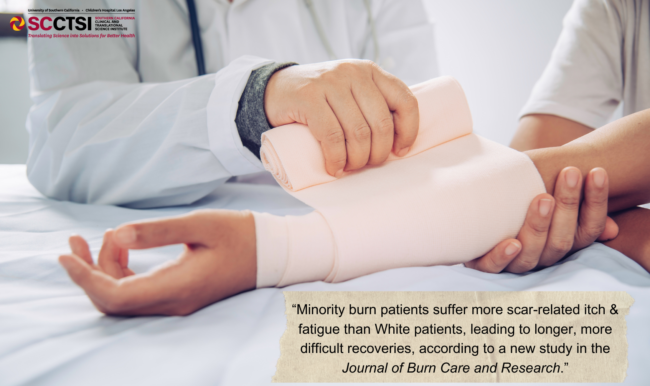SC CTSI biostatistician provides critical contributions to study of burn patient recovery
Minority burn patients suffer more scar-related itch and fatigue than White patients, leading to longer, more difficult recoveries, according to a new study in the Journal of Burn Care and Research.
A large majority of adult burn survivors experience significant itch associated with scarring, and many suffer from it for years. But certain demographic groups like Asians, Blacks and Hispanics are genetically more likely to form thicker scars than White patients because they tan more easily.

“Our hypothesis was that because Blacks and Hispanics have thicker scars, they would experience more itch and fatigue,” Yenikomshian said.
“We found that Black and Hispanic/Latino burn patients are reporting more itch than White patients at discharge, at six months, and at one year, they are still worse,” said Li Ding, MD, MPH, a biostatistician with the Biostatistics, Epidemiology and Research Design (BERD) group at SC CTSI who collaborated on the project. Fatigue scores were also higher for Black and Hispanic/Latino patients than for Whites.
This study of 893 total patients is one of many projects in which BERD experts collaborate with clinician-scientists to advance clinical and translational medicine.
“We at BERD have a long-term relationship with the Keck Department of Surgery to provide statistical analysis, study design, and collaborate on research papers and grant development,” Ding said. “When a faculty member in the department has a research project, they can reach out to us.”
Yenikomshian, for instance, is a frequent user of BERD expertise.
“When he has a research question already in mind, we can help him refine it so it’s analyzable,” said Ding. “Next, we propose an analysis method that can truly answer the research question he is trying to answer. We ensure the study design is effective and doable within the timeline and that the sample size calculation aligns with the design. Later, we ensure a correct interpretation of the results and, in the research paper, describe the limitations of the dataset.”
For the burn disparities study, the investigators analyzed patient outcomes from the multi-center National Institute on Disability, Independent Living, and Rehabilitation Research (NIDILRR) Burn Model System (BMS) National Database. This database collects patient demographics such as age, race and ethnicity, burn injury details, treatment, and outcomes longitudinally after discharge. Several studies have used the BMS database to analyze burn outcomes, including patient-reported pain or physical function.
The Yenikomshian team is the first to use the BMS to report worse outcomes regarding itch and fatigue experienced by minority patients compared to White patients.
The BMS database includes more than 2,000 variables. Yenikomshian and Ding pared them for statistical analysis. The variables they chose for analysis included two clinical symptoms (itch and fatigue), outcomes at three time points, and patients of three racial/ethnic populations from four institutes. Ding developed a multilevel linear mixed effects regression model to analyze associations between race/ethnicities and outcomes over time.
The investigators identified some ethnic or racial determinants of health that could also help drive worse outcomes for minority burn patients. For instance, Hispanic burn patients are significantly less likely to be discharged to higher level rehabilitation services than White patients. Black patients may have less trust in healthcare they receive and less access to healthcare after discharge.
Further research, the investigators noted, could identify gaps in care and propose avenues of treatment and support for minority patients. In the short-term, minority patients may benefit from additional counseling and focused treatments addressing itch and fatigue after burn injury.



